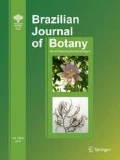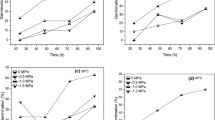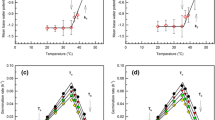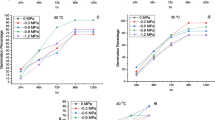Abstract
Seed germination is a biological process that is strongly affected by temperature and water potential. Our objective was to measure experimentally and model this combined effect and estimate robust parameter values that will assist researchers to estimate safflower germination rate under variable experimental conditions. A laboratory experiment was conducted to investigate the combined effect of seven temperatures regimes (10, 15, 20, 25, 30, 35 and 40 °C) and five water stress levels (0, −0.4, −0.8, −1.2 and −1.6 MPa) on safflower seed germination. The derived dataset was analyzed using two modeling approaches that combine temperature and water potential effects: the multiplicative and the hydrothermal time models. The associated parameter estimates for each model were determined through statistical optimization and model performance evaluated against an independent dataset. The hydrothermal time parameters were 493.3 MPa h, 8.2 °C, and −1.34 MPa for θ HT (hydrothermal time constant) T b (base temperature), and ψ b(50) (median base water potential) in sub-optimal temperatures, respectively. The parameter estimates for the multiplicative model were determined as 7.9 °C for T b, 21.4 °C for T o1 (lower optimal temperature), 29 °C for T o2 (upper optimal temperature), and 40 °C for T c (ceiling temperature); 0 MPa for WPc (critical water potential) and 1.18 h−1MPa−1 for water potential sensitivity coefficient (WPS); and 17.9 h for g o (physiological hours for seed germination). Model evaluation showed that the multiplicative model predicted time to 50 % of seed germination more accurately (RMSE = 4.3 h and R 2 = 0.98) than the hydrothermal time model (RMSE = 9.5 h and R 2 = 0.93).






Similar content being viewed by others
References
Adam NR, Dierig DA, Coffelt TA, Wintermeyer MJ, Mackey BE, Wall GW (2007) Cardinal temperatures for germination and early growth of two Lesquerella species. Ind Crops Prod 25:24–33
Aflakpui GKS (1996) Constant temperatures and the rate of seed germination in maize (Zea mays L.) of contrasting endosperm. Ghana J Agric Sci 29:33–38
Allen P (2003) When and how many? Hydrothermal models and the prediction of seed germination. New Phytol 158:1–3
Alvarado V, Bradford KJ (2002) A hydrothermal time model explains the cardinal temperatures for seed germination. Plant Cell Environ 25:1061–1069
Alvarado V, Bradford KJ (2005) Hydrothermal time analysis of seed dormancy in true (botanical) potato seeds. Seed Sci Res 15:77–88
Archontoulis SV, Miguez FM (2013) Nonlinear regression models and applications in agricultural research. Agron J 105:1–13
Archontoulis SV, Miguez FE, Moore KJ (2014) A methodology and an optimization tool to calibrate phenology of short-day species included in the APSIM PLANT model: application to soybean. Environ Modell Soft. doi:10.1016/j.envsoft.2014.04.009
Bair NB, Meyer SF, Allen PS (2006) A hydrothermal after-ripening time model for seed dormancy loss in Bromus tectorum L. Seed Sci Res 16:17–28
Bakhshandeh E, Ghadiryan R, Galeshi S, Soltani E (2011) Modelling the effects water stress and temperature on seed germination of Soybean (Glycine max L.) and Velvetleaf (Abutilion thephrasti med.). J Plant Prod 18:29–48
Bauer MC, Meyer SE, Allen PS (1998) A simulation model to predict seed dormancy loss in the field for Bromus tectorum L. J Exp Bot 49:1235–1244
Berti MT, Johnson BL (2008) Seed germination response of cuphea to temperature. Ind Crops Prod 27:17–21
Bewley JD, Black M (1978) Physiology and biochemistry of seeds in relation to germination. Springer, Berlin
Bewley JD, Black M (1994) Seeds: physiology of development and germination, 2nd edn. Plenum Press, New York
Bloomberg M, Sedcole JR, Mason EG, Buchan G (2009) Hydrothermal time germination models for radiata pine (Pinus radiata D.Don). Seed Sci Res 19:171–182
Bradford KJ (1986) Manipulation of seed water relations via osmotic priming to improve germination under stress conditions. HortSci 21:1105–1112
Bradford KJ (1990) A water relations analysis of seed germination rates. Plant Physiol 94:840–849
Bradford KJ (1995) Water relations in seed germination. In: Kigel J, Galili G (eds) Seed development and germination. Marcel Dekker, New York, pp 351–396
Bradford KJ (2002) Applications of hydrothermal time to quantifying and modelling seed germination and dormancy. Weed Sci 50:248–260
Bradford KJ (2005) Threshold models applied to seed germination ecology. New Phytol 165:338–341
Bradford KJ, Still DW (2004) Applications of hydrotime analysis in seed testing. Seed Technol 26:75–85
Cheng ZY, Bradford KJ (1999) Hydrothermal time analysis of tomato seed germination responses to priming treatments. J Exp Bot 50:89–99
Covell S, Ellis RH, Roberts EH, Summerfield RJ (1986) The influence of temperature on seed germination rate in grain legumes. I. A comparison of chickpea, lentil, soybean and cowpea at constant temperatures. J Exp Bot 37:705–715
Dahal P, Bradford KJ, Haigh AM (1993) The concept of hydrothermal time in seed germination and priming. In: Come D, Corbineau F (eds) Basic and applied aspects of seed biology. Proceedings of the Fourth International Workshop on Seeds, Angers, pp 1009–1014
Dajue L, Mündel HH (1996) Safflower. In: Padulosi S, Hammer K, Heller J (eds) Carthamus tinctorius L. Promoting the conservation and use of underutilized and neglected crops. Institute of Plant Genetic and Crop Plant Research, Gatersleben, Rome
Dordas CA, Sioulas C (2008) Safflower yield, chlorophyll content, photosynthesis, and water use efficiency response to nitrogen fertilization under rainfed conditions. Ind Crops Prod 27:75–85
Ekin Z (2005) Resurgence of safflower (Carthamus tinctorius L.) utilization: a global view. J Agron 4:83–87
Ellis RH, Covell S, Roberts EH, Summerfield RJ (1986) The influence of temperature on seed germination rate in grain legumes. II. Interspecific variation in chickpea (Cicer arietinum L.) at constant temperatures. J Exp Bot 37:1503–1515
Finch-Savage WE, Rowse HR, Dent KC (2005) Development of combined imbibition and hydrothermal threshold models to simulate maize (Zea mays) and chickpea (Cicer arietinum) seed germination in variable environments. New Phytol 165:825–838
Forcella F, Benech-Arnold RL, Sanchez R, Ghersa CM (2000) Modelling seedling emergence. Field Crops Res 67:123–139
Ghaderi-Far F, Soltani A, Sadeghipour HR (2008) Cardinal temperatures of germination in medicinal Pumpkin (Cucurbita pepo convar. pepo var. styriaca) Borago (Borago officinalis L.) and Black Cumin (Nigella sariva L.). Asian J Plant Sci 7:574–578
Ghaderi-Far F, Alimagham SM, Kameli AM, Jamli M (2012) Isabgol (Plantago ovata Forsk) seed germination and emergence as affected by environmental factors and planting depth. Int J Plant Prod 6:185–194
Grimm SS, Jones JW, Boote KJ, Hesketh JD (1993) Parameter estimation for predicting flowering date of soybean cultivars. Crop Sci 33:137–144
Grundy AC, Phelps K, Reader RJ, Burston S (2000) Modelling the germination of Stellaria media using the concept of hydrothermal time. New Phytol 148:433–444
Gummerson RJ (1986) The effect of constant temperatures and osmotic potential on the germination of sugar beet. J Exp Bot 37:729–741
Hardegree SP (2006a) Predicting germination response to temperature. I. Cardinal-temperature models and subpopulation-specific regression. Ann Bot 97:1115–1125
Hardegree SP (2006b) Predicting germination response to temperature. III. Model validation under field-variable temperature conditions. Ann Bot 98:827–834
Hardegree SP, Winstral AH (2006) Predicting germination response to temperature. II. Three-dimensional regression, statistical gridding and iterative-probit optimization using measured and interpolated-subpopulation data. Ann Bot 98:403–410
Jame YW, Cutforth HW (2004) Simulating the effect of temperature and sowing depth on germination and emergence of spring wheat. Agric For Meteorol 124:207–218
Jami Al-Ahmadi M, Kafi M (2007) Cardinal temperatures for germination of Kochia scoparia (L.). J Arid Environ 68:308–314
Jones JW, White J, Boote K, Hoogenboom G, Porter CH (2000) Phenology module in DSSAT v 4.0. Documentation and source code listing. Agricultural and Biological Engineering Department, University of Florida, Gainesville
Jones JW, Hoogenboom G, Porter CH, Boote KJ, Batchelor WD, Hunt LA, Wilkens PW, Singh U, Gijsman AJ, Ritchie JT (2003) The DSSAT cropping system model. Eur J Agron 18:235–265
Kamkar B, Jami Al-Ahmadi M, Mahdavi-Damghani AM, Villalobos FJ (2012) Quantification of the cardinal temperatures and thermal time requirement of opium poppy (Papaver somniferum L.) seeds to germinate using non-linear regression models. Ind Crops Prod 35:192–198
Kebreab E, Murdoch AJ (1999) Modelling the effects of water stress and temperature on germination rate of Orobanche aegyptiaca seeds. J Exp Bot 50:655–664
Larsen SU, Bailly C, Come D, Corbineau F (2004) Use of the hydrothermal time model to analyze interacting effects of water and temperature on germination of three grass species. Seed Sci Res 14:35–50
Meyer SE, Debaene-Gill SB, Allen PS (2000) Using hydrothermal time concepts to model seed germination response to temperature, dormancy loss, and priming effects in Elymus elymoides. Seed Sci Res 10:213–223
Michel BE, Kaufmann MR (1973) The osmotic potential of polyethylene glycol 6000. Plant Physiol 51:914–916
Qiu J, Bai Y, Oulman B, Romo JT (2006) Using thermal time models to predict seedling emergence of orchardgrass (Dactylis glomerata L.) under alternating temperature regimes. Seed Sci Res 16:261–271
Ritchie JT (1991) Wheat phasic development, In: Hanks RJ, Ritchie JT (eds.), Modelling plant and soil systems. Agronomy Monograph No. 31:31-54
Rowse HR, Finch-Savage WE (2003) Hydrothermal threshold models can describe the germination response of carrot (Daucus carota) and onion (Allium cepa) seed populations across both sub- and supra-optimal temperatures. New Phytol 158:101–108
SAS Institute Inc (2011) SAS/STAT 9.3 user’s guide, the PLS procedure, Cary
Schutte BJ, Regnier EE, Harrison SK, Schmoll JT, Spokas K, Forcella F (2008) A hydrothermal seedling emergence model for giant ragweed (Ambrosia trifida). Weed Sci 56:555–560
Setiyono TD, Cassman KG, Specht JE, Dobermann A, Weiss A, Yang H, Conley SP, Robinson AP, Pedersen P, De Bruin JL (2010) Simulation of soybean growth and yield in near-optimal growth conditions. Field Crops Res 119:161–174
Shafii B, Price WJ (2001) Estimation of cardinal temperatures in germination data analysis. J Agric Biol Environ Stat 6:356–366
Sinclair TR, Kitani S, Hinson K, Bruniard J, Horie T (1991) Soybean flowering date: linear and logistic models based on temperature and photoperiod. Crop Sci 31:786–790
Singh V, Nimbkar N (2007) Safflower (Carthamus tinctorius L.). In: Singh RJ (ed) Genetic resources, chromosome engineering, and crop improvement., Volume 4: Oilseed Crops FloridaCRC Press, Boca Raton, pp 167–194
Soltani E, Farzaneh S (2014) Hydrotime analysis for determination of seed vigour in cotton. Seed Sci Technol 42:260–273
Soltani A, Sinclair TR (2012) Modelling Physiology of Crop Development, Growth and Yield. CAB International, Wallingford
Soltani A, Zeinali E, Galeshi S, Latifi N (2002) Germination, seed reserve utilization and seedling growth of chickpea as affected by salinity and seed size. Seed Sci Technol 30:51–60
Soltani A, Hammer GL, Torabi B, Robertson MJ, Zeinali E (2006a) Modeling chickpea growth and development: phenological development. Field Crops Res 99:1–13
Soltani A, Robertson MJ, Torabi B, Yousefi-Daz M, Sarparast R (2006b) Modelling seedling emergence in chickpea as influenced by temperature and sowing depth. Agric For Meteorol 138:156–167
Soltani E, Galeshi S, Kamkar B, Akramghaderi F (2008) Modelling seed aging effects on the response of germination to temperature in wheat. Seed Sci Biotechnol 2:32–36
Soltani E, Soltani A, Galeshi S, Ghaderi-Far F, Zeinali E (2013a) Seed bank modelling of volunteer oil seed rape: from seeds fate in the soil to seedling emergence. Planta Daninha 31:267–279
Soltani E, Soltani A, Oveisi M (2013b) Modelling seed aging effect on wheat seedling emergence in drought stress: Optimizing Germin program to predict emergence pattern. J Crops Improv 15:147–160
Torabi B, Attarzadeh M, Soltani A (2013) Germination response to temperature in different safflower (Carthamus tinctorius) cultivars. Seed Technol 35:47–59
Windauer L, Altuna A, Benech-Arnold R (2007) Hydrotime analysis of Lesquerella fendleri seed germination responses to priming treatments. Ind Crops Prod 25:70–74
Windauer LB, Martinez J, Rapoport D, Wassner D, Benech-Arnold R (2011) Germination responses to temperature and water potential in Jatropha curcas seeds: a hydrotime model explains the difference between dormancy expression and dormancy induction at different incubation temperatures. Ann Bot. doi:10.1093/aob/mcr242
Yang HS, Dobermann A, Lindquist JL, Walters DT, Arkebauer TJ, Cassman KG (2004) Hybrid-maize-a maize simulation model that combines two crop modelling approaches. Field Crops Res 87:131–154
Yin X, van Laar HH (2005) Crop systems dynamics. an ecophysiological simulation model for genotype-by-environment interactions. Wageningen Academic Publishers, Wageningen
Author information
Authors and Affiliations
Corresponding author
Rights and permissions
About this article
Cite this article
Torabi, B., Soltani, E., Archontoulis, S.V. et al. Temperature and water potential effects on Carthamus tinctorius L. seed germination: measurements and modeling using hydrothermal and multiplicative approaches. Braz. J. Bot 39, 427–436 (2016). https://doi.org/10.1007/s40415-015-0243-x
Received:
Accepted:
Published:
Issue Date:
DOI: https://doi.org/10.1007/s40415-015-0243-x




